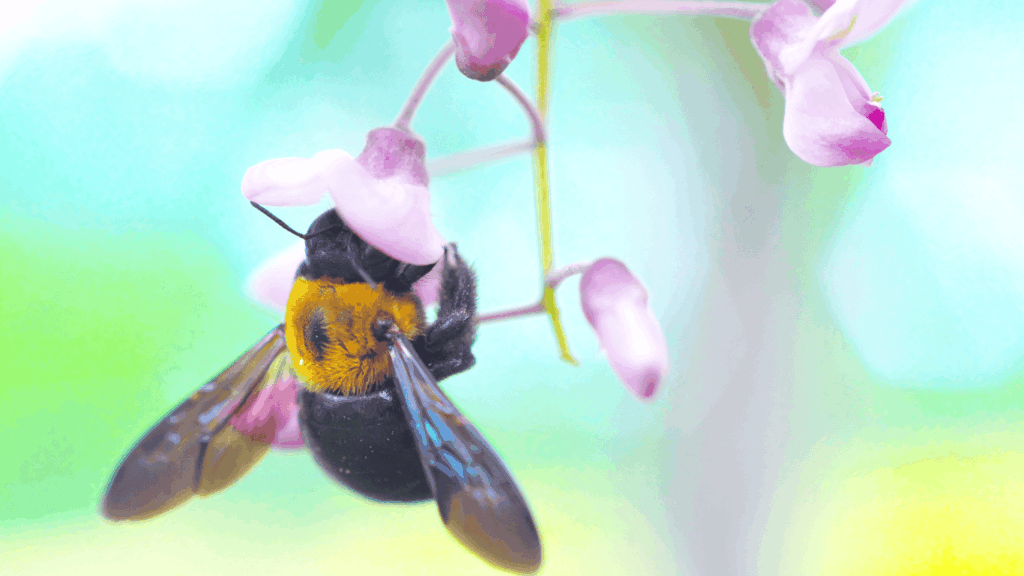
If you’ve noticed large, solitary bees buzzing around your wooden structures, it’s likely you’ve encountered carpenter bees. While they may seem harmless, these bees can cause significant damage to wooden structures, including fences, decks, and even your home. In this blog, we’ll explain what carpenter bees are, how to identify them, why they pose a threat, and most importantly, how to prevent and manage them.
What Are Carpenter Bees?
Carpenter bees (genus Xylocopa) are large, solitary bees that are often mistaken for bumblebees due to their similar size and appearance. Unlike bumblebees, however, carpenter bees have a smooth, shiny abdomen instead of the furry body that bumblebees are known for. Carpenter bees are primarily known for drilling into wood to build their nests. These bees typically nest in untreated, unpainted wood, which makes your fences, decks, eaves, and even wooden siding perfect targets for infestation.
Signs of Carpenter Bee Activity
Carpenter bees are often identified by the following signs:
- Holes in Wood: The most obvious sign is the small, round holes (approximately 1/2 inch in diameter) they bore into wooden structures. These holes are typically found on horizontal surfaces such as decks, beams, and eaves.
- Sawdust Piles: After boring into the wood, carpenter bees create small piles of sawdust (frass) beneath the entrance holes as they excavate tunnels.
- Buzzing: Carpenter bees can often be heard buzzing loudly as they hover around wooden surfaces, especially during the spring and summer months when they are active.
Visible Bee Activity: If you notice bees hovering around the same areas over several days, especially around wood surfaces, this could indicate a nesting site.
Why Are Carpenter Bees a Problem?
While carpenter bees do not sting unless provoked, they can cause significant damage to wooden structures. The bees burrow into wood to create nesting tunnels, and over time, this can weaken the structural integrity of buildings, decks, fences, and other outdoor wooden features. Left untreated, carpenter bee infestations can lead to costly repairs.
In addition, as the bees burrow deeper into the wood, they can attract other pests such as ants or termites, further complicating the issue.
Prevention and Management of Carpenter Bees
1. Seal Gaps and Cracks
The best way to prevent carpenter bees from nesting in your wood is to seal all cracks, holes, and gaps in your wooden structures. If you notice any small openings, fill them immediately with caulk or wood filler. The bees are particularly attracted to untreated or damaged wood, so ensure your outdoor structures are well-maintained.
2. Paint or Varnish Wood Surfaces
Carpenter bees are less likely to nest in painted or varnished wood. Coating wood surfaces with a protective finish helps deter them from boring into your property. Regularly paint or stain any exposed wood surfaces, particularly those that are not already naturally weathered.
3. Use Carpenter Bee Traps
Specially designed carpenter bee traps can help capture and remove these bees. These traps typically have an entrance hole that lures the bees inside, where they are trapped. Once captured, the bees can be safely removed and relocated.
4. Apply Insecticidal Dust or Spray
For immediate control, insecticidal dust or sprays can be applied to carpenter bee nests. These products are effective at killing the bees inside the tunnels. Be sure to follow all manufacturer instructions, and only apply treatments during the evening or early morning hours when the bees are less active.
5. Install Bee Deterrents
Certain essential oils, such as citronella, mint, and eucalyptus, have been shown to repel carpenter bees. You can create a homemade deterrent spray by mixing a few drops of essential oils with water and spraying it on wood surfaces where bees are active. Additionally, hanging up reflective objects like aluminum foil strips or wind chimes can sometimes discourage bees from nesting nearby.
6. Professional Pest Control
If you have a severe carpenter bee infestation, it may be best to contact a professional pest control service to safely and effectively remove the bees. An expert can identify nests, apply treatment, and prevent further damage to your property.
When to Call a Professional
If you’ve noticed a growing number of carpenter bees and your preventive measures haven’t been effective, it may be time to seek professional help. A pest control expert can assess the extent of the infestation, remove bees and nests safely, and offer long-term solutions to keep your property bee-free.
Protect Your Property from Carpenter Bees
Carpenter bees, while beneficial to the ecosystem as pollinators, can cause significant damage to your wooden structures. By taking preventive measures such as sealing wood gaps, painting surfaces, and using traps, you can reduce the risk of infestations. Regularly maintaining your property and being vigilant for signs of carpenter bees can help keep your outdoor spaces beautiful and safe.
At Blue Sparrow Lawn & Landscape, we’re committed to keeping your landscape healthy and pest-free. If you need assistance with carpenter bee management or any other pest-related concerns, feel free to reach out to our team for professional advice and services.
